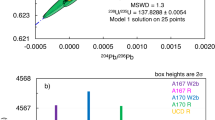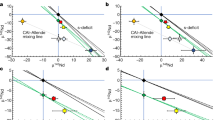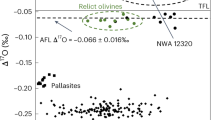Abstract
CLAYTON1 has elaborated on his unorthodox interpretation2 of the occurrence in meteorites of the decay products of the extinct radionuclides 129I and 244Pu. He has suggested that these radioactive species did not decay in the meteorites but rather in interstellar grains which, on the formation of the meteorites, were incorporated without much alteration. Thus, the concentration in the meteorites of the decay products does not reflect the time of meteorite formation relative to the cessation of nucleosynthesis but is essentially governed by the fraction of interstellar grains mixed with the meteoritic matter proper. If that is true, anomalies will occur in the isotopic composition of numerous elements. The decisive criterion of whether an over-abundance of a given isotope can be expected is the production yield during nucleosynthesis of a radioactive precursor; the half life of that precursor is of only minor importance.
This is a preview of subscription content, access via your institution
Access options
Subscribe to this journal
Receive 51 print issues and online access
$199.00 per year
only $3.90 per issue
Buy this article
- Purchase on Springer Link
- Instant access to full article PDF
Prices may be subject to local taxes which are calculated during checkout
Similar content being viewed by others
References
Clayton, D. D., Nature, 257, 36 (1975).
Clayton, D. D., Astrophys. J., 199, 765 (1975).
Woosley, S. E., Arnett, W. D., and Clayton, D. D., Astrophys. J. Supp. Ser., 26, 231 (1973).
Blander, M., and Fuchs, L. H., Geochim. cosmochim. Acta, (in the press).
Clayton, R. N., Grossman, L., and Mayeda, T. K., Science, 182, 485 (1973).
Gray, C. M., and Compston, W., Nature, 251, 495 (1974).
Papanastassiou, D. A., and Lee, T., J. geophys. Res. Lett., 1, 225 (1974).
Wanke, H., Baddenhausen, H., Palme, H., and Spettel, B., Earth planet. Sci. Lett., 23, 1 (1974).
Stegmann, W., and Begemann, F., Z. Naturf., 30 a, 968 (1975).
Nier, A. O., Phys. Rev., 77, 789 (1950).
Burnett, D. S., Lippolt, H. J., and Wasserburg, G. J., J. geophys. Res., 71, 1249 (1966).
Peters, J. G., Fowler, W. A., and Clayton, D. D., Astrophys. J., 173, 637 (1972).
Author information
Authors and Affiliations
Rights and permissions
About this article
Cite this article
BEGEMANN, F., STEGMANN, W. Implications from the absence of a 41K anomaly in an Allende inclusion. Nature 259, 549–550 (1976). https://doi.org/10.1038/259549a0
Received:
Accepted:
Issue Date:
DOI: https://doi.org/10.1038/259549a0
This article is cited by
-
Gerontology of the Allende meteorite
Nature (1979)
-
Allende meteorite—old age but normal isotopic composition of potassium
Nature (1979)
-
Supernovae and the origin of the solar system
Space Science Reviews (1979)
-
Precondensed matter: Key to the early solar system
The Moon and the Planets (1978)
Comments
By submitting a comment you agree to abide by our Terms and Community Guidelines. If you find something abusive or that does not comply with our terms or guidelines please flag it as inappropriate.



